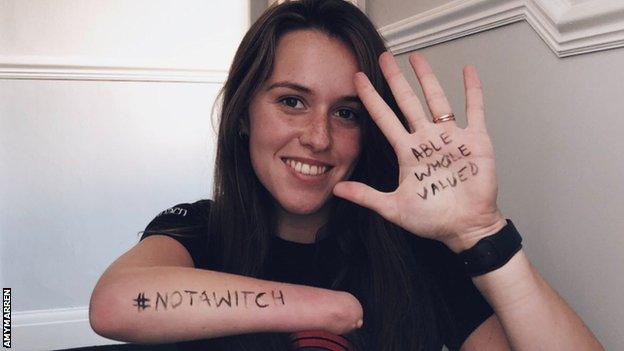The Witches: Why are Paralympians writing '#NotAWitch' on their bodies?
- Published

Former British Paralympic swimmer Amy Marren is among those who has objected to the film
"It feels like we've spiralled back into the dark ages where people with a disability are seen as weird, freaky and scary."
That is how Great Britain Paralympian Claire Cashmore felt watching 'The Witches' movie.
The former swimmer turned para-triathlete is now a celebrated, multiple Paralympic medal-winning athlete.
But as a child she was called "evil" and "disgusting" just because she had been born without a lower left arm.
The bullying left Cashmore feeling "so ashamed" of her appearance that she would try to hide her impairment to "avoid scaring people".
She is therefore able to speak with authority about the impact of ignorance, an issue many within the Paralympic movement have spoken up about, following the release of Warner Bros' 21st century adaptation of Roald Dahl's 1983 novel 'The Witches'.
In the film, actress Anne Hathaway - who plays the Grand High Witch - is depicted with three fingers on each hand, which differs from the original book, where witches had "thin curvy claws, like a cat".
On Thursday Hathaway apologised in a .
"I have recently learned that many people with limb differences, especially children, are in pain because of the portrayal of the Grand High Witch in The Witches," she said.
"As someone who really believes in inclusivity and really, really detests cruelty, I owe you all an apology for the pain caused.
"I am sorry. I did not connect limb difference with the GHW when the look of the character was brought to me; if I had, I assure you this never would have happened."
Cashmore told 大象传媒 Sport: "We need to get rid of negative stereotypes and encourage positive feelings around disability, but I worry it [the movie] could further the stigma around disability."
"Having fingers missing is a real-life disability, which 'cat-like-claws' is not, so I just don't understand why they changed it.
"It would be less of a problem if it was purely for adults, but there will be kids who now think it's OK to call children with missing fingers 'ugly witches' because they've seen it in the film."
On Twitter, Claire Cashmore questioned how the film impacts children's perceptions of limb difference
Cashmore works with the charity Reach - which supports children with upper limb differences - and says there has been "outrage" among the community since 'The Witches' opened in cinemas on 22 October in America.
Reach itself says the detail in the film "has the potential to be extremely damaging" and is "shockingly out of touch" with the times.
Former British Paralympic swimmer Amy Marren is among the thousands of people with limb impairments who have shown their objection to the film by writing #NotAWitch on their bodies and posting photographs on their social media accounts.
She worries children watching the film will be "unaware it massively exaggerates" the original book and is concerned that "limb differences begin to be feared".
The movie's creators told the 大象传媒 they "regret any offence caused" by the film.
"We the filmmakers and Warner Bros Pictures are deeply saddened to learn that our depiction of fictional characters in The Witches could upset people with disabilities.
"In adapting the original story, we worked with designers and artists to come up with a new interpretation of the cat-like claws that are described in the book.
"It was never the intention for viewers to feel that the fantastical, non-human creatures were meant to represent them. This film is about the power of kindness and friendship."
"It is our hope that families and children can enjoy the film and embrace this empowering, love-filled theme.
Cashmore has seen attitudes towards Paralympic athletes "transform" since making her Games debut with bronze at Athens 2004.
She accepts the film's directors did not intend to cause upset, but feels situations like this would be less likely to happen if there were more disabled people working within the film industry specifically and the workplace in general.
"For me it's about representation in the whole system," Cashmore told 大象传媒 Sport. "From the bottom to the top we need views represented from wider society and that includes disability.
"The biggest thing that's come from this is that it's started a conversation where people are realising we need education in order to get rid of stigmas and celebrate differences."
The film has also been criticised by celebrities, including comedian Alex Brooker, who has hand and arm impairments and told the 大象传媒 that the images "jarred quite a lot" and could "add to the stigma" around disability.
Alex Brooker says the way the film depicts limb difference is "heartbreaking"